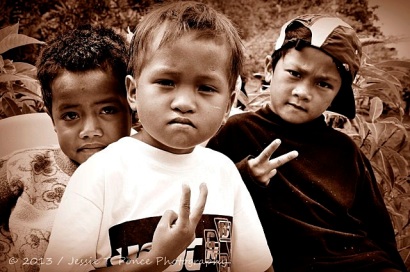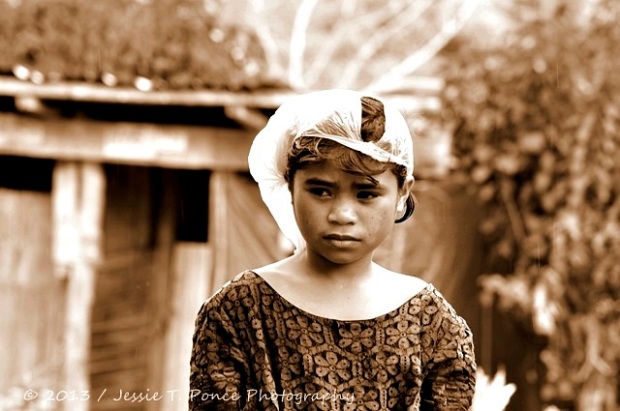In Search of Lice

Young Matigsalug boys strike a contemporary ‘tough guy’ pose
August 2013: After two hours of navigating the scenic, winding road away from Davao City towards the mountainous villages southeast of the city; we arrived at Barangay Salumay, a sleepy community inhabited by some of the indigenous peoples of the region.
Having caught our breath from a brief stop, we then turned away from the main road and started negotiating a tire track that apparently has not seen much traffic in recent years. The local leaders, excited about our visit, bulldozed the difficult sections of the track the previous day but a heavy rain the night before only managed to turn the track into an obstacle course of knee-deep quagmire. For almost an hour, I pushed the 4×4 truck I was driving through the alternating mud and rocks over the hills and alongside deep ravines until we arrived at a small community of Matigsalugs. Sitio Contract.
The Matigsalugs are a gentle people of Malayo-Polynesian origin. It is said that they originally inhabited the mouth of Salug River, which is now Davao City, but frequent raids by passing pirates forced the tribe to move further upstream and then, when the Muslims and other groups of Indonesian origin came and harassed them, they moved further inland and further up the mountains where, in earlier years, they practiced a hunting-and-gathering lifestyle with minimal agriculture efforts. It was only very recently, through the influence of migrant farmers and visiting traders, when the Matigsalugs shifted to sedentary land cultivation with more or less permanent villages.

After getting lice treatment, the girls, with their heads covered in plastic bags, wait for their hair to be washed
I was with a group of doctors, dentists, nurses, ministers, and volunteers of a local church. Our mission in the area was to deliver medical, dental, and other services to the Matigsalug tribe. Advance groups have been deployed to the area before we arrived and so the whole village, Sitio Contract, was ready and warmly welcomed us when we arrived.
Surrounded by mountains and magnificent scenery, the village was composed of a few dozen houses, a village center with a basketball court, a few sari-sari stores, and a 5 classroom elementary school. Being in a very high elevation, the village climate was cold despite the bright sun and the atmosphere was festive with the presence of visitors from the big city.
We were ushered to the school premises where the services were to be rendered. There was a queue for each type of service. Elderly and sick village folks trooped to the area where medical services were being provided. An occasional groan can be heard from a classroom where some dentists were extracting teeth or filling cavities. In another corner, ministers’ wives were providing hot nutritious meals to young kids and their mothers. And, at the back of a classroom overlooking a grand view of the surrounding mountains, young men waited for their turn to get a much-needed haircut. While taking photos, I silently wished my barber’s window had this majestic view.
Roaming around the school compound with my camera, I noticed a crowd of kids in another section of the school ground. Surprisingly, the service provided in that section was for treating lice — those tiny, creepy creatures that thrive on blood and body fluids and inhabit the shady surfaces of the human scalp. Even more surprising to me was the fact that almost all the young boys and girls congregated in this section. All of them had lice!
And there I met Ana, a pretty young girl who had a dark, curly hair and who looked more mature than her age. Ana and her friends were teary-eyed as they listened to a nurse tell stories about lice and how to prevent them. Their facial expressions not only struck my photographic eye but also touched my heart. At this time and age where the modern world is bombarded by overrated health and hygiene products, some remote areas are still struggling with issues as basic as lice treatment and prevention.

And then the head washing begins. The wonderful feeling of being cared for and treated of lice was obvious in their faces.

After getting a haircut, the discomfort still shows in this boy’s face as a volunteer and another kid tries to rid his head of the remaining lice and their nits
A louse is a parasite. They are scavengers, feeding on skin and other debris found on the host’s body, but some species feed on sebaceous secretions and blood. In humans, different species of louse inhabit the scalp and pubic hair. While they are not that dangerous and they don’t spread disease, they are contagious, unhygienic,, extremely annoying, and heir bites may cause a child’s scalp to become itchy and inflamed, and persistent scratching may lead to skin irritation and even infection. Treating lice can be difficult. A louse’s egg, commonly called a nit, attach their eggs to their host’s hair with specialized saliva or hair bond which is very difficult to sever without specialized products.

And then there was also this coordinated “search and destroy” technique which the young girls know all too well
The Matigsalug kids, after a brief talk with the nurses and volunteers, quickly became comfortable with the idea of submitting themselves for lice treatment. Having lice is a persistent problem which affects them all and for which they were all eager to find a solution. Boys and girls registered for the service and queued for the treatment. The sight of them with their heads wrapped in plastic bags while waiting for their hair to get washed was amusing but also telling of their simplicity and sincere interest in getting treatment. And then, when it was time to get the shower, I saw in their faces the happiness of being cared for by somebody else other than their mothers. It was a heartwarming sight. And when the treatment was over, they joyfully went back to their kiddie chores and giggly games, as if it was a totally new day. In my eyes, it seemed that each has become more of a child than he or she already was.

From the teary-eyed girl I met earlier, Ana was now all smiles having her curly black hair washed and emptied of lice



















I like the intenseness with which you approach the subjects of your photos.
LikeLike
Thanks. Capturing facial expressions of persons in unique situations is something i’m trying to understand more of. Cheers.
LikeLike
Beautiful photographs!
LikeLike
Thank you, Virginia!
LikeLike
So strange, and so wonderful that concern and care is in your heart (s). Thanks for the glimpse, so far away. M
LikeLike
Thank you. It was self-gratifying to have rendered simple services to this community.
LikeLike
Very nice story and documentation via photographs.
LikeLike
Thanks, disperser.
LikeLike
This was an outstanding blog. Loved it. Thanks for sharing.
LikeLike
Thank you so much, Sandra.
LikeLike
Having worked with kids in my career, this post hits home. Excellent photo journalism, Jesse.
LikeLike
Hello, Jane. I know we both love working with kids and photographing them. Thanks for the kind comment.
LikeLike
These are great photographs. I recently returned from a Global Outreach project with The Shepherd Institute for Lice Solutions in West Palm Beach, Florida. A team traveled to Guatemala to treat head lice in an Orphanage that could not get past head lice. These children had already been treated been treated with over the counter products brought over from the United States on multiple occasions. We were able to check everyone and treat those in need. In addition, we educated everyone on head lice, how to identify, treat and prevent. We trained older girls and staff in head lice removal, using the Shepherd Method Strand by Strand technique. This is a safe, effective technique and leaves the population with a method to treat in the future. It is rewarding to help those in need.
http://www.heartlandhealthyheads.com
LikeLike
Reblogged this on Contemplations of a Restless Mind.
LikeLike
Pingback: Yellow on Gray | A Traveller's Tale
Pingback: Green on Gray | A Traveller's Tale
a beautiful depiction, and write up of, a not so pretty terribleness that goes with living in these areas.
LikeLike
Beautiful pictures of real life!
LikeLike
Thank you!
LikeLike
Beautiful!
LikeLike